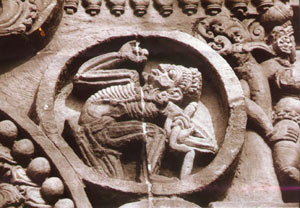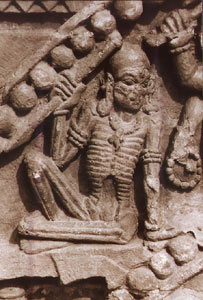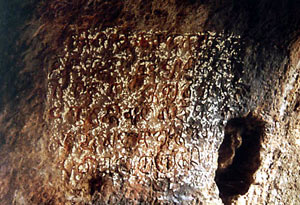By Deepak Bhattacharya 1; L M Mukherjee 2
Abstract
Skeletal picture & role of muscles are indicated clearly in temple stone art of 7th AD. Name, nativity parentage of a surgeon, a hospital, its sovereign, possible manager or administrator are indicated in rock inscription dated to 9tth AD. This paper subtly & latently seeks to bring out the hitherto hidden chapter of material evidence of ancient Indian school of medicine in extant cognate group of man made stone art archaeology, presented on a background of acknowledged secondary evidence of such ancient school and contrasted vis-a-vis modern science based knowledge. It also throws up the possibility of knowledge in anatomical dissection and a possible practice in Osteology & Invasive medicine 1500 yrs ago and the possibility of regional variation or separate schools within the then geography of Indian subcontinent ..
Key Words
Atharva Veda, Atreya-Charaka, Susruta, Bhringi, Chamunda, Parasuram Temple, Skeletal Picture, Bhubaneswar, Ancient Indian School, Ancient Osteology.
Introduction
The Indian system of medicine [ human health science & care ] alias the Atreya – Charaka school is said to have a long illustrious list of researchers, practitioners & commentators of which the following names are mentioned as token – Dhanwantari, Atreya, Charaka, Dribhabala, Jivanananda, Susruta, Chakrapani dutta, Dheda, Gangadhar, Aparaka, Vighneswar, Sulapani, Mitra Mishra, Nanda Pandita, Bhagabata, Bhoja, Dallana, etc 1.
Non medical texts viz.-Atharva veda, Agni purana, Vishnu Dharmottara purana, Sathpatha Brahmana, Yagyanvalaka – Samhita, also deal with medicine, hygiene & health care 1.
1 – Director, Oddisi Research Laboratory, Kedar Gouri Road, Bhubaneswar -751002. [email protected]
2 – Prof & Head, Dept. of Surgery, MKCG Medical Collage, Berhampore, Orissa
The Indian school of art in durable plastic has also been held as equally or more ancient, well organised in story telling, is noted for profuse inflorescence from 3rd millennia B C ( Mohenjo daro & Harappa ) 22, at the least 23. Ancient Indians were as well strong in astronomy & load structure engineering 24.
At some point of time somewhere such streams may have come together for social or / & mutual benefit or for as yet undermined reasons or by chance and in the process an indelible evidence may have been created. In the absence of original texts 1 such material evidence if any, assumes added significance. Thus commenced our search.
Discussion
The Grecian Hippocratic school of medicine is dated to 6th B.C. and is not known for human dissection studies 1. TheVedas dated to millennias B.C. ( so said ) have similar prominent and exhaustive reference to non – invasive medicine 1. The Atharva Veda specifically enumerates treatment for leprosy 2 as well deals with human skeleton, etc4. The Atreya system as handed down by Charaka ( 4 – 5th B.C. )1 compiled by Jivanananda 3 and termed by modern researchers as Atreya -Charaka system # 3 or Indian medicine * clearly states that human body consists of 360 bones inclusive of 32 teeth ( danta ), 60 phalanges( anguli ), 20 long bones ( salaka ), 2 heels ( Parshni ), marrow ( majhnah ) contained in hallowed bones called ( nalakas ), 45 back bones alias spinal column ( pristha-gat-asthi ), four sira kapala or 4 pan shaped cranial bones ..1. Nails and components of the cervical vertebrae were accurately numbered under sub-headings; the human body was divided into 6 major parts( angas ) or six-partite alias Sadaanga 1. Susruta ( possibly was ) the first physician-surgeon ( saila chikitshaka ), describes a range of surgical instruments 5 and principles of operations 6. Laparotomy is dealt by Charaka 7. Atreya specialised in medicine 1. etc.
While it is known that Grecian specialists visited India 1. The reverse remains unreported.
#. The Atreya School is said to forbid use of aged and diseased skeleton, the Orissa School could be an independent or reformed or a later one; While Chamunda & Bhringi are all India Characters.
*. Scholars from Tubingen University- & other German & English scholars -are said to have thrown much light in this regard, in early part of last century.
No archaeology ( material evidence – in Osteology ) has so far been reported, neither any comparative studies made for or with material evidence. In this paper, sculptures of two skeletal figure are studied from musculo – skeletal angle, details identified, compared and contrasted with actual.
Location
Hindu, Saivic ,45 feet high, west facing, best preserved monument of earliest cognate group, ornately curved, enshrining the Saivic aniconic composite symbol, composed of a cylinder, a triangle, a circle & a center point, placed in a square, colloquially termed as Shiva Linga and Shakti 14. The monument being dated by Archaeological Survey of India ( ASI ) to 7th A.D ,10; By Indologists to 6th and 7th A.D 11,12,13,; by Bhattacharya, Naik, et.al to between 170 BC – 261 A D ## .
At the front, at about 15 feet height on this monument called the temple of Parasurameswar on Kedar Gouri road at Bhubaneswar, in the province of Orissa, India ( eastern sea board ) 15, presents two sculptures showing anatomical details.
These two sculptures were singled out for closer, detailed & comparative study.
##. By use of astronomical model – which is a new yet to be accepted methodology.
Methodology
Visited site, examined through binoculars and close up photographs by climbing atop Jagamohana ( hall of audience ) repeatedly for close physical examination. Compared & contrasted with standard publications & own hands on experience. Studied & compared with standard Hindu Iconographic & Historical / Archaeological texts.
Subject
One is called Bhringi 17 & the other is called Chamunda 19.
As per Hindu religious mythology both are ardent followers of Saivism ( Hindu super deity Lord Siva being the icon ). Interesting & informative lore are associated with these two mythic / religious characters14. While the art of Bhringi is rare, the art of Chamunda fulminates in Orissa till late middle ages. Both also known as cult images.
 |
| Sculpture No. 1 ( Bhringi ) 16 & 17 |
Crowned or head band wearing human figure, bent, on knee, looking at something held with right hand, head turned backward – up, in other hand ( L ) a crooked human phallus ( linga ), which has interesting multi made interpretations, 15. Skeletal bones other than skull are humerus ( forearm ), radius and ulna which appear superimposed ( arm below the elbow ), exact eleven ribs of the thoracic cage ( chest ), with ( exact ) seven numbers of ribs joining the sternum ( breast bone ), an ossified xiphoid process ( indicative of – age ), a flattish or strong femur ( thigh bone ), suggestive depiction of knee joint with patella ( Knee cap ) drawn up almost correctly, one bone of lower leg ( as if superimposed ), a prominent tarsal ( heel bone ) exhibited with deliberate twist of the ankle joint but for this ( twist ) such part ( large Tarsal ) of the anatomy could not have been presented. Joints and muscles are almost alike as in dissected human body. Functional position of the joints and muscles in respect to posture is much in tune with actuality 8,9.
 |
| Sculpture No.2 ( Chamunda ) 18 & 19 |
The art is in bass relief inscribed in a medallion & measures approx. 8 inches in dia.
The human figure here is fully developed and part by part comparable to the present day human anatomy. The figure is sitting upright on ground, left arm and fore arm straight, fully stretched palm pressed against ground. Fully developed deltoid, extensor, triceps ( fore arm muscles ), pollicis ( thumb muscles ) which grips tightly a weapon. Both upper limbs reveals the gross impression of musculature. 8,9.
The Skeletal picture indicates a single bone in right hand ( may be visual effect ) while in the left both radius and ulna are shown. The impression of a single ( thigh bone ) femur is clear while the lower leg portion does not clearly depict the fibula ( calf bone ). Nevertheless, the gastrocnemius ( calf-muscles ) are flexed and intact, thus obstructing the fibula ( which is normally narrow ). The skull and the cranium needs closer examination ( in situ ). Veins, and the gut are conspicuous by absence +. Seven ribs joins the sternum ( breast bone ) while five are shown below, The clavicle shown distinctly 8,9. Although marginally erroneous, a impression of extreme ageing is conjured by the beholder.
![Ganesha Cave; Rock Inscription [ Udaigiri ]](/wp-content/uploads/2014/12/DBhattacharya3-fig3.jpg) |
| Ganesha Cave; Rock Inscription [ Udaigiri ] |
 |
| Dhauli Cave; Rock Inscription |
 |
| The Cave at Dhauli |
The sculpture is in a panel, in bass relief & measures approx. 10 inches in height.
+. In the art of later period the blood vessels are boldly & vividly reproduced.
Mythology
In kimbadanti ( tradition / mythology ) it is unambiguously stated that Hindu goddess Parvati being vexed with Bhringi curses him to loose all muscles; as a result Bhringi looses his ability to stand erect !
This piece of information surely is precise & cannot be without methodic & learned observation. The ancients have utilised this information in mythic or religious story telling as well, which is a logical lateral step.
Epigraphy
In the above we have presented archaeological evidence in the form of stone art ( durable plastic ) & hinted about the corroborating kimbadanti ( tradition / mythology ). In India epigraphy followed art. Epigraphy ( the science of historical inscription ) as noted in Orissa provides us the following consonant material.
1 – In the world famous cave complex at Udayagiri ( SW of Bhubaneswar ) in the Ganesha Gumpha ( Ganesha cave ) is a inscription in Sanskrit verse, Brahmi characters that talks about a Vesaka ( physician ) named Bhimata ,s/o Ijya ( mother ) & Nannata ( father ). Experts have read it as “Bhimata the physician, who was born of the womb of Ijya and s/o Nannata was a resident of Biraja ( modern Jajpur )..” Historians, archaeologists & epigraphists have dated this to 9th AD 24.
2 – At the world famous site of Dhauli in another cave, is another inscription, self dated to 9th AD, which has been read as “.In the regnal yr.93 of Sri Santikara deva ( Kara dynasty ) a / the monastery called Arghya – Varati was constructed by ( possibly ) one Bhatta Loyomaka for Vesaka ( surgeon ) Bhimata who was born of the womb of Ijya & Vaidya ( physician ) Nannata .” 25; ( Bhatta = Brahmin, while Loyomaka = name of that Brahmin ).
Conclusion
( i ) Arteries, veins & gut not depicted @, ( ii ) Knowledge of anatomy appears to be restricted to skeleton and role of muscles,( iii ) The musculo – skeletal anatomy as presented in these sculptural art are very much in consonance with actuality, ( iv ) A possible conscious attempt to demonstrate the skeletal format, functional positions and role of joints and muscles as is done in medical texts ,( v ) The almost sure possibility of a blue print ( for the crafts-men ) which in turn must have evolved out of exercise in dissection,( vi ) The associated mythology is surprisingly in consonance with the idea that sans muscles the skeleton would collapse 14,16,18 and thus further reinforce the above as a possibility; so do the art or Chitra Bhasa 20 of the twin sculpture indicate ( vii ) Both being presented in a very important placement i.e. the front façade, the subject or the message may be sought to be given a very high importance indeed. ( viii ) Undeniable data input is that by 9th AD at Bhubaneswar was a surgeon who was s/o of a physician i.e. medicine & surgery are mentioned separately ( ix ) He moved in from Jajpur – 100 kms north of Bhubaneswar ( x ) It means health care science was also practiced elsewhere in Orissa in 9thAD ( xi ) To practice health care a hospital was built ( xii ) This hospital has been called as Arghya Bharati. In ancient Prakrit phone Arogya would be pronounced as ‘Arghya’ i.e. it could be Aroyga Bharati ( healing center ) !
@ – It is shown in sculptures of latter date & a evolutionary series is noted.
The art of many a Hindu cult icons including the Jyana Yoga Dakshina Murti ( learning & knowledge bestowing icon ) of Mahadeva ( super deity ) is shown holding half skull in inverted position, is a subject that invites study.
Monuments and Temples as almanacs of human knowledge and achievements of civilizations have been in vogue since the days of Pyramid or even earlier. Assuming that this monument is of 7th A.D and not earlier, it means 1600 yrs ago dissection of human body was probably in vogue in territories as presently known as India ( Orissa in particular ) in Occidental term & as Bharata in ancient Indian & indigenous term.
More importantly public presentation of such skeleton in Chitra Bhasa ( narration via bass relief art ) 20 with associated facets was an accepted means and an essential one. Intimate knowledge could only allow such striking accuracy, lively presentation. Extant archaeology of 7th A.D. & onwards has many a comparable presentation, many better evolved.
Clothed in mythic lore these two sculptures & its series may in actuality have been presentation of anatomy & associated knowledge to the initiated ( medical texts & practice being lost with rise in rabid Brahmanism & conceit 1 ), the general beholder & to the faithful. Each would receive from such almanac to his own capacity, & liking.
On all India basis much may be awaiting for similar correlation to complete the missing link. Such archaeology is not limited to Orissa. In variety, size, finish, numbers, placement, independent presentations, time scale spread, Orissa stands out. Epigraphic evidence seals the issue.
Acknowledgement
Temple priests namely Mr. Debaraj, Manoj, Tapan & Prasanta and as well A S I officers namely Dr. S. Maiti & Mr. P. K. Mahapatra helped physically repeatedly I in climbing on to the monument, in conducting close physical study & in photography.
Such help is gratefully acknowledged. The work is financed by Mrs. Mamata Bhattacharya.
Reference
- Rudolf Hoernale C.I.E – Studies in the medicine of ancient India, Part I-Osteology or bones of the human body– OXFORD. Clarendon press 1907.
- Atharva Veda Samhita – Medicine chapter.
- Charaka Samhita– V th chapter-Anatomical section( Sarira Sthana ). Also enumerates the methodology of preparation of human body before dissection.
- Journal of Asiatic Society, 1907-pp10-12.
- Susruta – Sutra Sthana – ch 7, 8.
- Susruta – Sutra Sthana – ch 25.
- Charaka Chikitsa Sthana – ch 18, vers 179 ( Jivananda ed. pp – 653 ).
- The Body Atlas-Dorling Kinderley, London-ISBN -0-7513-5004-4 pp-12, 21, 23,33, 34,35, 37, 38, 49,56,58, 59, 61, 63.
- Gadner,gray,O’Rahilly,ANATOMY –A Regional Study of Human Structure, – IV Ed.-1975, Asian; W B Saunders & Igaku shoin, PA- London – Tokyo : ISBN 0-7216-4018-4 : ch – 11, 13, 14, 15, 16, 17, 18, 21, 23, 25, 26, 40, 48, 52, 60.
- Archaeological Survey of India – monument site board.
- Prof. K.C.Panigrahi, Archaeological Remains at Bhubaneswar; Kitab Mahal,2nd ed. pp-26-32.
- V.Dehejia – Early Stone Temples of Orissa, ISBN 0-7069-0567-9,1979,pp-13, 76-84.
- T.E.Donaldson – Hindu temple art of Orissa – vol I -pp-51; Leiden-1985-87.
- Bhattacharya, et.al. The magnificent monument of Sri Parasurameswar – an interdisciplinary study; ISBN-900557-0-4-73 ( publisher being sought ).
- INTACH – EKAMRA KHETRA Heritage zone plan; April 1989.
- T.G.Rao, Elements of Hindu Iconography -Vol-II,Part-I,pp-322,323.
- V.Dehegia – Early Stone Temples of Orissa, ISBN 0-7069-0567-9,1979,pp-79.
- T.G.Rao, Elements of Hindu Iconography, Vol-1,Part-II,pp-386.
- K.C.Panigrahi, Archaeological Remains at Bhubaneswar; Kitab Mahal,2nd ed.pp-232-33.
- T.G.Rao, Elements of Hindu Iconography -Vol – II,Part-II,pp-474.
- J. P. Jhosi & Asko Parpola; Corpus of Indian Seals & Inscriptions – Memoirs of Archaeological Survey of India, No 86- 1987
- India Today; News magazine, Cover Story – world’s oldest city found, Vol XXVII No 6; dt. 11th Feb, 2000- pp 38-43
- http://www.grahamhancock.com/forum/DBhattacharya1.php
- R.D.Bannerjee;Epigraphica Indica, ASI,1982 : Vol-XII(1915-16),pp167,PL-XVII
- Ibid A S I – 1983, Vol-XIX(1927-28),pp263-64 ( PL by Survey of India ).
ORISSA REVIEW; VOL – LX No. 1; August 2003; pp 73-79. Govt. Of Orissa; 751001; Lokasampark Bhavan




